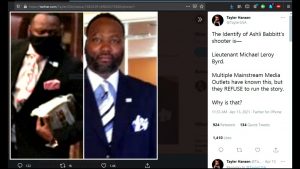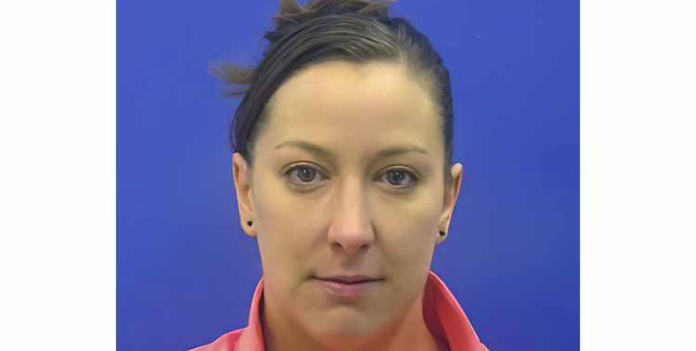(Paul Sperry, RealClearInvestigations) Kicking off the first hearing of the House Select Committee investigating the U.S. Capitol riot, Chairman Bennie Thompson, a Mississippi Democrat, promised to fully investigate “the facts of what happened on Jan. 6,” calling it “a scene of violence in the citadel of democracy.”
But over the next 3½ hours, he and other Democrats, along with their handpicked Republican panelists and police witnesses, never mentioned the most lethal act committed that day — the fatal Capitol Police shooting of unarmed protester Ashli Babbitt.
It was the only shot fired during the entire riot.
This omission angered Babbitt’s family and a number of Republicans who maintain that the Select Committee and the Capitol Police are covering up the circumstances surrounding her death.
Questions linger over the shooting, especially whether the officer who fired the fatal shot warned Babbitt to stop before he opened fire as she attempted to breach a barricaded door inside the Capitol Building.
The officer’s lawyer insists his client not only issued such a command, but did so loudly and clearly.
However, in an interview with RealClearInvestigations, Babbitt family attorney Terry Roberts said he has gathered evidence indicating the officer, a plainclothes police lieutenant, remained silent.
Far from warning Babbitt he would shoot, Roberts said the officer “ambushed” her from the side where she could not see he had taken up position in a hall doorway and had trained his weapon on her.
“It’s not debatable,” said Roberts. “There was no warning.”
A Maryland personal-injury lawyer who specializes in police misconduct cases, Roberts has won several million dollars for victims of police brutality.
He said he is preparing to file a wrongful-death lawsuit against the Capitol Police and the officer, seeking more than $10 million in damages.
Babbitt, 35, was fatally wounded as she attempted to climb through the broken window above a door leading to the House chamber, where lawmakers were being evacuated.
Standing to the side of a pile of furniture blocking the doors and out of Babbitt’s view, the officer took aim with his Glock service pistol, striking her in the left shoulder.
Babbitt fell back from the doorway to the floor. She was transported to Washington Hospital Center, where she died from injuries sustained from the .40-caliber bullet wound.

More than six months after the shooting, the U.S. Capitol Police still refuse to release the name of the officer. But several sources have identified him as Lt. Michael L. Byrd, a 53-year-old veteran of the force who was serving as commander of the House Chamber Section of the Capitol Police on Jan. 6. He has not returned to duty and remains on paid administrative leave. Attempts to reach Byrd were unsuccessful.
Though Byrd appears to have been cleared of criminal wrongdoing, he may still be subject to civil action. If Babbitt was not given an opportunity to obey commands before she was shot, it could figure prominently in the family’s planned wrongful-death suit against the officer. Roberts said he has interviewed several witnesses who were standing outside the Speaker’s Lobby with Babbitt, and that they’ll testify they did not hear the officer issue “any kind of warning.”
He also said video recordings his investigators have analyzed reveal that other police who were in the hallway with the officer did not react as expected before he fired. He said they seemed to be caught unaware as he opened fire. Roberts said he has lined up expert witnesses, including ex-cops and use-of-force experts, who will testify that the officers behind him in the Speaker’s Lobby would have taken cover or crouched and pulled their own weapons if they heard the lieutenant give repeated warnings he was going to shoot. Instead, Roberts said, they appeared to be casually standing or walking around in the lobby in the seconds leading up to the shooting.
“Those other officers were within earshot. If he’s yelling, they certainly aren’t showing any reaction to it,” he said. “If he was giving any kind of warning, why didn’t they react?”
Roberts added that no warnings can be heard coming from the officer in any videos taken at the scene.
The officer’s lawyer, Mark Schamel, insists his client issued verbal commands and warnings to Babbitt.
“He was screaming, ‘Stay back! Stay back! Don’t come in here!’” Schamel said.
Schamel said witness statements back him up. He explained the lieutenant’s commands were not picked up on video recordings because the footage was shot on the other side of the doors where dozens of rioters were shouting and banging and drowning out his words. And he said his client could not be seen yelling out the instructions because his mouth was covered by a mask he wore as part of COVID-19 protections.
It’s not clear if this critical issue was resolved by the investigation of the shooting by the Justice Department, which concluded in April that “there is insufficient evidence to support a criminal prosecution” of the officer for “willfully” violating Babbitt’s civil rights, though it did not rule out the possibility he acted out of “panic” or “even poor judgment.” Justice investigators reportedly did not pursue murder or manslaughter charges.
“They cleared him real fast,” U.S. Capitol Police Labor Committee Chairman Gus Papathanasiou said. “I was surprised.”
“I’m not sure how he was justified shooting her when there was a SWAT team right behind her,” added a veteran Capitol officer, referring to three heavily armed USCP officers who had positioned themselves between the doors and the mob. “They saw no immediate threat.”
The officer spoke on the condition of anonymity to discuss a sensitive matter. A Capitol Police spokeswoman would not say if the officer’s actions were consistent with use-of-force policies, which are not publicly available. In a statement released earlier this month, however, USCP noted that it is “increasing its use-of-force … training.”
Schamel said his client received his training primarily at the Federal Law Enforcement Training Centers in Glynco, Ga., where Capitol Police recruits spend about two months before coming back for another two months of agency-specific training. Although the FLETC training emphasizes use-of-force decisions through simulated-shooting exercises, Capitol Police officers are not trained for riot-control situations on the scale of Jan. 6.
“We were trained in what to do if gunmen tried to storm the Capitol, but we were not trained in what to do if hundreds of people decided to rush the building,” former Capitol Police officer Patrick Skinner said.
On Jan. 6, he added, police were unsure whether they were facing an imminent deadly threat or whether they were authorized to use deadly force.
“There was only one incident of deadly force by a police officer,” Skinner noted. “Every instinct of those [other] police officers was to not shoot.”
A former federal inspector general told RealClearInvestigations that even the Capitol Police are relatively unprepared to react to the kind of threat posed on Jan. 6 in which a mob tried to beat down doors leading to the House chamber.
“This is not meant pejoratively but just as a fact, but the [Capitol Police] is far from being some kind of elite law enforcement body,” the inspector general said, speaking on condition of anonymity. “Its principal function is to assist tourists, maintain decorum in a tourist environment, and help out members of Congress and their staffs.”
Roberts said as part of the discovery process, he plans to seek the shooting officer’s training records and his discipline file containing any infractions or complaints of misconduct. He noted that in February 2019, Byrd was investigated for leaving his department-issued Glock-22 firearm unattended in a restroom on the House side of the Capitol, even though the potent weapon, which fires .40-caliber rounds, has no manual safety to prevent unintended firing. The abandoned gun was discovered by another officer during a routine security sweep.
A Capitol Police spokeswoman would not say what, if any, disciplinary actions were administered against the officer. Unlike other police forces, it does not have to disclose records on police misconduct.
The Photo Evidence
Also, Roberts said the officer appeared to lack trigger discipline, judging from photos taken by a freelance photographer inside the House chamber before the shooting down the hall in the Speaker’s Lobby.
“He’s gunslinging like some cowboy,” the lawyer said.
In one of the freelancer’s photos obtained by RCI, the officer can be seen advancing toward the door of the chamber while several other law enforcement officers had taken position behind a barricade. His Glock-22 is slung low at his side pointed in the direction of the other officers, whose backs are to him, and his finger appears to be on the trigger.
The veteran Capitol Police officer who spoke to RCI on the condition of anonymity said his colleague was not following department firearms training, which requires officers to keep their weapons pointed in a safe direction while making sure of what’s in front of and beyond a target, and to keep the finger off the trigger until ready to fire.
“His trigger finger shouldn’t be inside the trigger guard and the gun shouldn’t be pointed at other officers. He’s even pointing it in the direction of a member of Congress,” the fellow officer said, referring to Rep. Markwayne Mullin (R-Okla.), a former professional mixed-martial-arts fighter who had joined the scrum in front of the chamber doors.
“I can’t tell you how many officers have contacted me to say that what that guy did doesn’t pass muster,” Roberts said in an extensive interview. “No one has come forward to say this was justified homicide, not even the Justice Department.”
“The way he did it — hiding in a room and then popping out and firing — is a problem,” Roberts added. “If his objective was to stop her, he didn’t need to shoot. He could have got out in front of her and used a number of other methods of less-lethal force. He could have tried to cuff her.”
Police have confirmed that Babbitt, an Air Force veteran, was unarmed. (If arrested, she would have faced unlawful entry and disorderly conduct on Capitol grounds charges, police sources say.)
“I would call what he did an ambush,” Roberts continued, “I don’t think he’s a good officer. I think he’s reckless.”
While Roberts argued Babbitt did not pose a threat, the officer’s lawyer insisted that his client was acting to protect himself and lawmakers from “bodily harm.”
“He was acting within his training,” Schamel said. “Lethal force is appropriate if the situation puts you or others in fear of imminent bodily harm.”
Added Schamel: “There should be a training video on how he handled that situation. What he did was unbelievable heroism.”
Roberts argued that he could have retreated if he feared for his life, as other officers did that day — and later received medals for heroism — but Schamel countered that he was guarding a critical chokepoint and saved a “potential massacre of lawmakers and staff” by the mob.
“The speaker may have been escorted out of the area, but there were still at least 100 people including lawmakers in the hallway behind my client,” Schamel said.
Still, Republican lawmakers want to know why SWAT team members standing behind Babbitt before she was shot were not more alarmed.
“They were right next to her and saw no threat, certainly no lethal threat,” said GOP Rep. Paul Gosar, who sits on the House Oversight Committee.
He and other Republicans are demanding the Select Committee call the SWAT members to testify about what they heard and saw before the shooting.
“Why were there no warnings given or escalation of command and force in proper law enforcement technique?” Gosar asked…Original Source…

